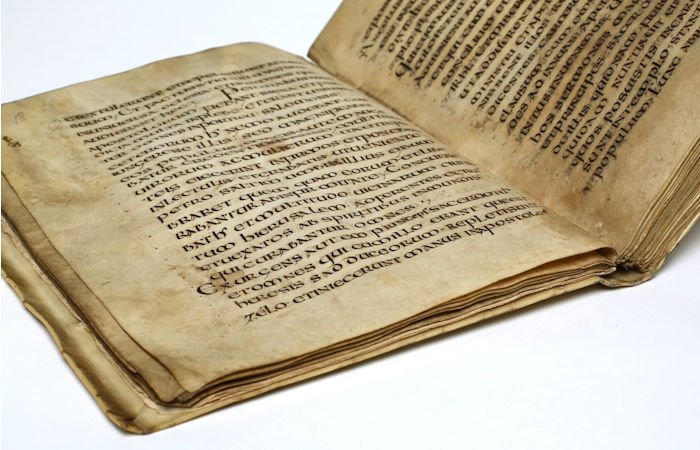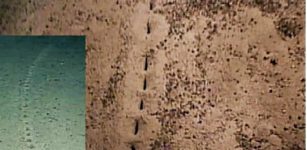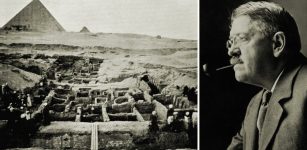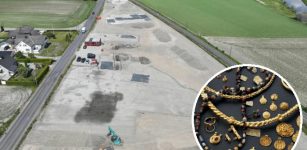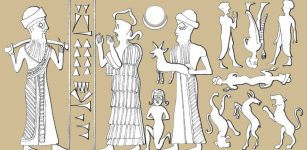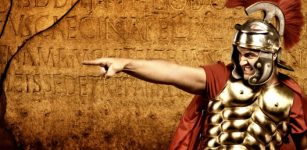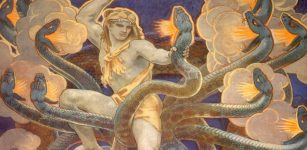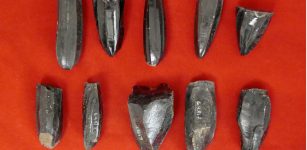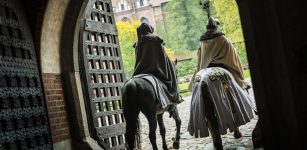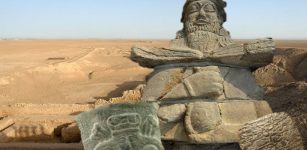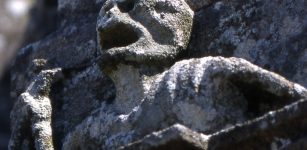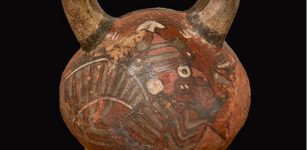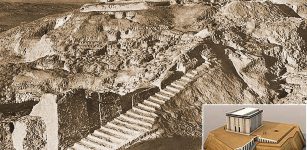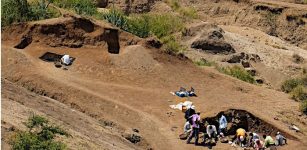Secretly Engraved Woman Name Discovered In Medieval Manuscript – Who Was Eadburg?
Conny Waters - AncientPages.com - A series of exciting inscriptions, almost invisible to the naked eye, have been discovered in the margins of an important eighth-century manuscript in the Bodleian Library, MS Selden Supra 30. Revealed through state-of-the-art 3D recording technology by the ARCHiOx project, these marginal annotations provide tantalizing new insights into this manuscript’s history and its links to women, particularly to a woman called Eadburg.
Bodleian MS. Selden Supra 30 open at pp. 18-19. Credit: Bodleian Library
Bodleian Library, MS. Selden Supra 30 is a copy of the Acts of the Apostles, a New Testament book written in Latin. It is a small volume, measuring only 229 x 176 mm (only slightly bigger than an A5 piece of paper).
Like most surviving manuscripts from this period, MS. Selden Supra 30 does not contain a formal colophon or scribal note recording when, where, and by whom it was made.
However, certain features of this manuscript, including the style of uncial script used to copy the text, demonstrate that it was produced in England, most likely somewhere in the kingdom of Kent, probably in the first half of the eighth century (i.e., between c. 700 and c. 750 AD).
MS. Selden Supra 30 was certainly in Kent by the fourteenth century when a shelf mark was added to p. 1 showing that it was then in the library of the monastery of St Augustine’s in Canterbury.
Prayers added to p. 70, which was originally left blank, suggest, however, that very early in its history MS. Selden Supra 30 was owned and used by a woman.
These prayers were copied in the same type of script as the rest of the manuscript but by a different scribe to the two responsible for copying its main text.
The opening page of MS. Selden Supra 30 (p. 1) which has suffered damage and is now significantly discoloured. The shelf mark from St Augustine’s, Canterbury (Di. I. G. III) is visible in the upper margin. Credit: Bodleian Library
The first prayer is a petition to God made by an anonymous woman, described as God’s “unworthy servant” (indignam famulam).
This strongly suggests that, at the time the prayer was added, MS. Selden Supra 30 was being used by a woman, or a group of women. The prayer may have been copied into the manuscript by a female scribe.
The formula of this prayer is unique and does not survive in any other manuscript. It could have been composed by the petitioner herself.
In 1935, in the first edition of Vol. 2 of Codices Latini Antiquiores, Elias Avery Lowe, then a Reader in Palaeography at the University of Oxford, suggested that another addition made to MS. Selden Supra 30 could provide further evidence of its links to women.
Lowe recorded, for the first time in print, that the letters EADB and +E+ had been incised into the lower margin of p. 47. He noticed that the letters had been cut into the parchment with force, apparently using a knife, slicing through the upper surface of the membrane.
Lowe suggested that these letters were abbreviated forms of the female name Eadburh/Eadburg.
Discovering Eadburg
Studying MS. Selden Supra 30 in the Weston Library’s Rare Books and Manuscripts Reading Room in 2022, Jessica Hodgkinson, a Ph.D. student at the University of Leicester, funded by the AHRC Midlands4Cities consortium, spotted another inscription in the lower margin of p. 18. This inscription had never been noticed before. It was very small and almost invisible to the naked eye but appeared to contain Eadburg’s name written in full.
State-of-the-art technology has now not only confirmed this new inscription, but revealed several other instances of Eadburg’s name, alongside many more early marginal additions, incised into the parchment of MS Selden Supra 30. These discoveries provide new and exciting insights into the use of this book by a woman called Eadburg in eighth-century England.
Academics are now trying to identify who the mysterious Eadburg was.
“There are only a limited number of surviving early medieval manuscripts which contain clear internal evidence of a woman having created, owned or used them.
Most of these manuscripts are from the continent – it is much rarer to find evidence of this in surviving manuscripts which were made and used in the geographical area we now call England.
It’s a hugely significant and very powerful text – the word of God, conveyed through the apostles. And I think that might be at least part of the reason why somebody chose to write Eadburg’s name into it, so that she was close to that," Hodgkinson told the Guardian.
Readers and owners of early medieval manuscripts, both men and women, sometimes added their names to books, usually in ink, but occasionally, as here, in drypoint.
Eadburg’s name could also be a mark of ownership or evidence of reading. Although small in scale, and faint, someone, perhaps Eadburg herself, was evidently keen to preserve her name in the pages of this book to be seen by subsequent readers. What is unusual about Eadburg’s name, however, is that it appears here, in full or in abbreviated forms, 15 times.
Eadburg’s name is written on the opening page of the manuscript (p. 1). It overlaps part of the top of the enlarged decorated initial P which begins the text. Here, her name is preceded by a cross (+).
"Discovering Eadburg's name provides new and exciting evidence of links between women, books, and literate culture in the early medieval period.
These are not random doodles. They are deliberate interactions with the text. It is possible that Eadburg herself added her name into the margins.
If so, by making her mark in a book she interacted with and which held meaning for her, she has left a tangible record of her presence that has survived for hundreds of years.
I hope my study of the inscriptions will reveal more about who Eadburg was and who added her name to this book and why," Hodgkinson told the BBC.
She also added:" "I was intrigued when I first saw the etchings. I was leaning, very carefully, over the manuscript looking at it from all angles to make sure my eyes were not deceiving me.
"We think Eadburg might have been an abbess from Kent but there is so much more to discover. This feels like just the first chapter."
John Barrett, the Bodleian Libraries' senior photographer and ARCHiOx technical lead, said: "This is the first time this specific technology has been used to successfully record annotations of this kind.
Researchers at the Bodleian Library in Oxford used cutting-edge technology to capture the 3D surface of the ancient manuscript. Credit: Bodleian Library
"I have spent the last ten months making 3D recordings of originals from a range of collections within the library and this discovery has been exciting to behold for all involved."
The Bodleian Library informs Eadburg’s name or initials are etched into several pages, sometimes next to contemporaneous dry-point drawings. But who was she? More work on the newly discovered additions may bring us closer to answering this question.
We know of nine women called Eadburg living in England at some point between the seventh and tenth centuries (for details see the online Prosopography of Anglo-Saxon England). Other sources provide some tantalizing clues that might help identify the Eadburg of MS. Selden Supra 30.
Charter evidence suggests that a woman called Eadburg was abbess of a female religious community at Minster-in-Thanet, in Kent from at least 733 until her death sometime between 748 and 761. As Lowe suggested in 1935, her dates and location correspond with the palaeographic assessment of the script of MS Selden Supra 30.
Abbess Eadburg of Minster-in-Thanet may also be the woman of the same name who corresponded with Boniface, the West Saxon missionary bishop and Church reformer. He became archbishop of Mainz in 732 and was martyred by pagans in Frisia in 754. Surviving letters show that Boniface held Eadburg in high esteem and that she sent books to him in Francia. He commissioned from her a deluxe copy of St Peter’s Epistles to be written in gold.
Boniface’s friend clearly had access to manuscripts and the means to make them. As such she is an especially strong candidate for the woman whose name was etched into the margins of MS. Selden Supra 30.
Written by Conny Waters - AncientPages.com Staff Writer

